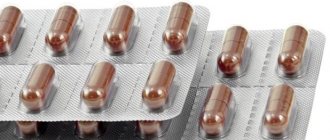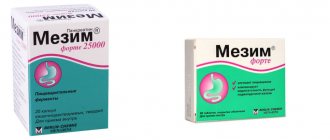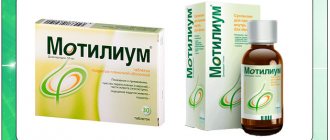Panangin forte is a medicine that improves metabolic processes in the myocardium.
With a lack of potassium and magnesium in the body, hypertension, heart rhythm disturbances, and sclerosis of the coronary vessels can develop. Compared to regular Panangin, this medicine contains a larger number of active ingredients.
The medication is indicated for use by people suffering from arrhythmia, heart failure and healthy patients for the prevention of heart pathologies. Potassium aspartate and magnesium aspartate, which are part of Panangin Forte, are intensively absorbed in the intestine, mainly in the small intestine. Excreted by the kidneys.
Release form and composition
The drug is available only in tablet form. The color of the dragee is white or beige. Each capsule is coated with a film shell, which gives its surface an uneven and shiny appearance. One tablet contains the following components:
- potassium aspartate – 280 mg;
- magnesium aspartate – 316 mg;
- corn starch;
- potato starch;
- povidone;
- talc;
- magnesium stearate.
The film coating of the tablets consists of:
- methacrylic acid;
- talc;
- copolymer;
- macrogol;
- titanium dioxide
Panangin Forte tablets are available in special bottles of 60 capsules each.
Pharmacological effect
Thanks to the use of the medicine, it is possible to have a positive effect on the cardiovascular system and the entire body as a whole. Potassium and magnesium are valuable components that play a critical role in the formation of connections between intracellular structures and macromolecules in the mechanism of contractility of human muscle tissue. When the balance of potassium, sodium, magnesium and calcium ions in the body is disturbed, the functioning of the myocardium deteriorates, which leads to the development of hypertension, atherosclerosis, arrhythmias, cardiac conduction disorders and other heart failures.
Panangin Forte helps to establish metabolic processes, improves the contractile function of the heart muscle, and restores the tone of the nerve and muscle structures of the myocardium. In addition, the magnesium content in the preparation helps improve the enzyme reactions of the heart, which ensures normal contractility of the organ and reduces the heart's need for oxygen. Magnesium also prevents the development of coronary disease and is an excellent prevention of many complications in heart and vascular diseases.
Panangin Forte
Panangin Forte is a drug intended to replenish magnesium and potassium in the body.
Release form and composition
The drug is available in the form of film-coated tablets: biconvex, oval, white or almost white, with a slight glossiness, engraved “A83” on one side, almost odorless, white or almost white on the break (15 pcs. in blisters, in cardboard packaging 2, 4 or 6 blisters and instructions for use of Panangin Forte).
Composition per film-coated tablet:
- active ingredients: magnesium aspartate (in the form of magnesium aspartate tetrahydrate) – 280 mg, potassium aspartate (in the form of potassium aspartate hemihydrate) – 316 mg;
- auxiliary components of the tablet core: potato starch, colloidal silicon dioxide, corn starch, povidone K30, magnesium stearate, talc;
- film shell: macrogol 6000, butyl methacrylate copolymer, talc, titanium dioxide.
Pharmacological properties
Pharmacodynamics
Potassium and magnesium are the most important intracellular cations. They play an important role in the work of many enzymes, in the mechanism of muscle contractility, in the formation of connections between intracellular structures and macromolecules.
The ratio of magnesium, potassium, sodium and calcium ions inside cells and in the extracellular space affects the contractility of the heart muscle. Endogenous aspartic acid is a conductor of ions: due to the slight dissociation of its salts, it promotes the penetration of ions (in the form of complex compounds) into the cell.
Magnesium aspartate and potassium aspartate improve the metabolism of the heart muscle. With a lack of magnesium and/or potassium ions, the susceptibility to the development of conditions and diseases such as atherosclerosis of the coronary arteries, arterial hypertension and metabolic changes in the myocardium increases.
Pharmacokinetics
Magnesium aspartate and potassium aspartate are actively absorbed from the gastrointestinal tract, mainly in the small intestine.
Potassium and magnesium are excreted by the kidneys.
Indications for use
Panangin Forte is used to eliminate the deficiency of magnesium and potassium in chronic heart failure, various manifestations of coronary heart disease (including acute myocardial infarction) and heart rhythm disturbances (including arrhythmias due to an overdose of cardiac glycosides).
The drug is used as an adjuvant simultaneously with other necessary therapy.
Contraindications
- chronic and acute renal failure;
- state of dehydration;
- anuria, oliguria;
- acute metabolic acidosis;
- chronic insufficiency of the adrenal cortex (Addison's disease);
- increased levels of magnesium and/or potassium in the blood serum;
- pathological hemolysis;
- atrioventricular block I, II or III degree;
- cardiogenic and other shock;
- myasthenia gravis;
- violation of amino acid metabolism;
- children and adolescents up to 18 years of age;
- hypersensitivity to individual components.
Relative (Panangin Forte is used with caution):
- pregnancy period (especially the first trimester);
- breastfeeding period.
Panangin Forte: instructions for use (dosage and method)
Panangin Forte tablets are taken orally, after meals, with a sufficient amount of water or other liquid. The drug should not be taken before meals, as its effectiveness is reduced in the acidic environment of the stomach.
The recommended daily dose of Panangin Forte is 3 tablets (1 piece three times a day). This same dose is the maximum.
Before using the medicine, you should consult a doctor.
Side effects
- digestive system: vomiting, nausea, burning or discomfort in the epigastric region (especially in patients with cholecystitis or anacid gastritis), diarrhea;
- cardiovascular system: atrioventricular block, paradoxical reaction (increase in the number of extrasystoles);
- water and electrolyte balance: hypermagnesemia (manifested by a feeling of thirst, facial flushing, hyporeflexia, decreased blood pressure, convulsions and respiratory depression), hyperkalemia (manifested by nausea, vomiting, paresthesia and diarrhea).
Overdose
To date, no cases of overdose of Panangin Forte have been registered. Large and ultra-high doses of the drug increase the risk of hypermagnesemia and hyperkalemia.
Symptoms of hypermagnesemia include nausea and vomiting, decreased blood pressure, decreased neuromuscular excitability, and lethargy. In the case of a sharp increase in the concentration of magnesium ions in the blood serum, suppression of tendon reflexes is observed, respiratory paralysis occurs and coma may occur.
Symptoms of hyperkalemia are heart rhythm disturbances (atrioventricular block, bradycardia, cardiac arrest, arrhythmias), paresthesia, myasthenia gravis, confusion, and increased fatigue.
Treatment consists of discontinuing Panangin Forte and providing the necessary symptomatic therapy. The patient is administered intravenous calcium chloride solution at a rate of 100 mg/min. Hemodialysis is effective.
special instructions
In patients with diseases accompanied by hyperkalemia, plasma potassium levels should be regularly monitored during treatment with the drug.
Impact on the ability to drive vehicles and complex mechanisms
The effect of Panangin Forte on the patient's ability to drive vehicles or operate other complex mechanisms has not been studied, but there is no reason to believe that such an effect is possible.
Use during pregnancy and lactation
The drug should be used with caution during pregnancy. In this case, it is necessary to take into account the expected benefit for the mother and the possible risk to the fetus.
Magnesium aspartate and potassium aspartate are secreted into breast milk, so the use of Panangin Forte during breastfeeding is not recommended.
Use in childhood
Panangin Forte is not prescribed to children and adolescents under 18 years of age, since its safety and effectiveness for this age group have not been established.
For impaired renal function
Panangin Forte is contraindicated in patients with acute and chronic renal failure, anuria and oliguria.
Drug interactions
Simultaneous administration of potassium supplements and glucocorticosteroids eliminates hypokalemia caused by glucocorticosteroids.
Combined use with beta-blockers, angiotensin-converting enzyme inhibitors, potassium-sparing diuretics, non-steroidal anti-inflammatory drugs, heparin and cyclosporine increases the likelihood of hyperkalemia, including asystole and arrhythmia.
Potassium and drugs containing it help reduce unwanted side reactions of cardiac glycosides.
Panangin Forte enhances the negative bathmotropic effect (decreased cardiac excitability) and the negative dromotropic effect (deterioration of cardiac conduction) of antiarrhythmic drugs.
Magnesium reduces the therapeutic effect of tetracycline, streptomycin, polymyxin B and neomycin.
Anesthetic agents enhance the inhibitory effect of magnesium-containing drugs on the central nervous system.
Concomitant use with dexamethonium, atracurium, suxamethonium and succinyl chloride may lead to increased neuromuscular blockade.
Calcium supplements reduce the effectiveness of magnesium-containing products; Calcitriol increases plasma magnesium concentrations.
Medicines that have an enveloping and astringent effect reduce the absorption of magnesium and potassium aspartate from the digestive tract, so the interval between taking such medicines and Panangin Forte should be at least 3 hours.
Analogs
Analogs of Panangin Forte are Asparkam-L, Asparkam Avexima, Asparkam, Panangin, Asparkam-UBF, etc.
Terms and conditions of storage
Store out of the reach of children, at a temperature not exceeding 25 °C.
The shelf life of the tablets is 3 years.
Conditions for dispensing from pharmacies
Available without a prescription.
Reviews about Panangin Fort
There are almost no negative reviews about Panangin Fort. Patients actively recommend this drug for use, as it perfectly replenishes the deficiency of potassium and magnesium in the body, helps improve the functioning of the heart muscle, and helps with cramps and pulling sensations in the legs. The tablets are not only effective, but also inexpensive. When used correctly, there are almost no side effects.
The disadvantage is usually the large size of the tablets (they are quite large), which makes them difficult to take.
Price for Panangin Forte in pharmacies
Price for Panangin Forte in packs of 60 pcs. (15 tablets in a blister, 4 blisters in a cardboard pack) is 220–340 rubles.
What is the difference between Panangin forte and Panangin?
The difference between Panangin Forte and regular Panangin lies primarily in the concentration of active ingredients. The first drug contains twice as much potassium and magnesium, so this medicine is taken one tablet 3 times a day, unlike Panangin, which is taken 2 pills three times a day.
The increased content of active ingredients in Panangin Forte also affected the price. This drug costs twice as much as Panangin. The latter, in addition to the tablet form, is available in the form of an injection solution. This drug has greater bioavailability than tablets.
Buy Panangin forte tablets 316mg+280mg No. 60 in pharmacies
Instructions for use Panangin forte tab. 316mg+280mg No. 60 Dosage forms tablets 316mg+280mg Synonyms Asparkam Potassium and magnesium aspartate Berlin-Chemie Panangin Group Drugs regulating water-electrolyte balance International nonproprietary name Potassium and magnesium aspartate Manufacturers Gedeon Richter (Hungary) Composition per tablet: Tablet core Active substances: potassium aspartate 316.00 mg (in the form of potassium aspartate hemihydrate 332.60 mg), magnesium aspartate 280.00 mg (in the form of magnesium aspartate tetrahydrate 350.00 mg); Excipients: corn starch 172.20 mg, talc 20.00 mg, magnesium stearate 8.00 mg, potato starch 6.60 mg, povidone K30 6.60 mg, colloidal silicon dioxide 4.00 mg; Tablet shell: talc 7.30 mg, butyl methacrylate copolymer 6.00 mg, titanium dioxide (color index: CI 77891, E171) 5.30 mg, macrogol-6000 1.40 mg. Description Oval, biconvex, film-coated tablets, white or almost white, with a slightly glossy surface, engraved “A83” on one side, almost odorless. On a cross section it is white or almost white in color. Pharmacotherapeutic group: potassium and magnesium preparation. ATC code: A12СХ Pharmacological properties Pharmacodynamics The most important intracellular cations of potassium (K) and magnesium (Mg++) play a key role in the functioning of numerous enzymes, in the formation of connections between macromolecules and intracellular structures and in the mechanism of muscle contractility. The intra- and extracellular ratio of potassium, calcium, sodium and magnesium ions affects myocardial contractility. Endogenous aspartate acts as a conductor of ions: it has a high affinity for cells, due to the slight dissociation of its salts, ions in the form of complex compounds penetrate into the cell. Magnesium aspartate and potassium aspartate improve myocardial metabolism. Lack of magnesium/potassium predisposes to the development of arterial hypertension, atherosclerosis of the coronary arteries, arrhythmias and metabolic changes in the myocardium. Each tablet of the drug Panangin® Forte contains 280 mg of magnesium aspartate and 316 mg of potassium aspartate, which is 2 times higher than the content of active ingredients in the drug Panangin®, film-coated tablets. The daily dose of the drug Panangin® Forte: 1 tablet 3 times a day, corresponds to the daily dose of the drug Panangin®: 2 tablets 3 times a day. Taking a single dose of Panangin® Forte in the form of one tablet makes treatment more convenient for the patient. Pharmacokinetics Potassium and magnesium aspartates are intensively absorbed in the intestine, mainly in the small intestine. Excreted by the kidneys. Indications for use To eliminate potassium and magnesium deficiency as part of combination therapy for various manifestations of coronary heart disease (including acute myocardial infarction); chronic heart failure; heart rhythm disturbances (including arrhythmias caused by an overdose of cardiac glycosides). Contraindications Hypersensitivity to any of the components of the drug, acute and chronic renal failure, hyperkalemia, hypermagnesemia, Addison's disease, atrioventricular block I-III degree, shock (including cardiogenic) (blood pressure less than 90 mm Hg), metabolic disorders amino acids, myasthenia gravis, hemolysis, acute metabolic acidosis, dehydration state, age under 18 years (efficacy and safety have not been established). With caution Pregnancy (especially in the first trimester of pregnancy) and the period of breastfeeding. Use during pregnancy and breastfeeding Use is possible if the potential benefit to the mother outweighs the possible risk to the fetus. Potassium and magnesium aspartate pass into breast milk. If it is necessary to take the drug during breastfeeding, breastfeeding should be stopped. Directions for use and dosage: Before use, you should consult your doctor. Take orally, without chewing and with plenty of water. Panangin® Forte should be taken after meals, because... the acidic environment of the stomach reduces its effectiveness. Recommended daily dose: 1 tablet 3 times a day. Maximum daily dose: 1 tablet 3 times a day. Side effects Possible nausea, vomiting, diarrhea, discomfort or burning sensation in the epigastric region (in patients with anacid gastritis or cholecystitis), atrioventricular block, paradoxical reaction (increased number of extrasystoles), hyperkalemia (nausea, vomiting, diarrhea, paresthesia), hypermagnesemia ( facial flushing, thirst, decreased blood pressure, hyporeflexia, respiratory depression, convulsions). If any of these adverse reactions become serious, or you notice the occurrence of adverse reactions not listed in these instructions, you should consult a doctor. Overdose The risk of symptoms of hyperkalemia and hypermagnesemia increases. Symptoms of hyperkalemia: increased fatigue, myasthenia gravis, paresthesia, confusion, cardiac arrhythmia (bradycardia, atrioventricular block, arrhythmias, cardiac arrest). Symptoms of hypermagnesemia: decreased neuromuscular excitability, nausea, vomiting, lethargy, decreased blood pressure. With a sharp increase in the content of magnesium ions in the blood: inhibition of deep tendon reflexes, respiratory paralysis, coma. Treatment: symptomatic therapy - intravenous administration of calcium chloride at a dose of 100 mg/min, if necessary - hemodialysis. Interaction with other drugs Pharmacodynamic interaction When used together with potassium-sparing diuretics (triamterene, spironolactone), beta-blockers, cyclosporine, heparin, angiotensin-converting enzyme (ACE) inhibitors, non-steroidal anti-inflammatory drugs, the risk of developing hyperkalemia up to the development of arrhythmia and asystole increases. The simultaneous use of potassium supplements with glucocorticosteroids eliminates hypokalemia caused by the latter. Potassium reduces the undesirable effects of cardiac glycosides. Panangin® Forte enhances the negative dromo- and bathmotropic effects of antiarrhythmic drugs. Magnesium reduces the effects of neomycin, polymyxin B, tetracycline and streptomycin. Anesthetics increase the inhibitory effect of magnesium preparations on the central nervous system; when used simultaneously with atracuronium, decamethonium, succinyl chloride and suxamethonium, neuromuscular blockade may be enhanced. Calcitriol increases the content of magnesium in the blood plasma, calcium supplements reduce the effects of magnesium supplements. Pharmacokinetic interaction Drugs with an astringent and enveloping effect reduce the absorption of magnesium aspartate and potassium aspartate in the gastrointestinal tract, therefore it is necessary to maintain a three-hour interval between oral administration of Panangin® Forte with the above medications. Storage conditions : At a temperature not exceeding 30 °C. Keep out of the reach of children! Shelf life: 2 years. Do not use after the expiration date stated on the package.
Contraindications
Instructions for use contain a description of diseases for which the use of the drug is prohibited. These include:
- severe cases of myasthenia gravis;
- cardiogenic shock;
- heart block;
- the patient's age is under 18 years;
- Addison's disease;
- personal intolerance to the active or auxiliary components of the drug;
- serious kidney pathologies, including chronic as well as acute failure;
- excess magnesium and potassium. The use of the drug can provoke hyperkalemia, hypermagnesemia;
- any diseases accompanied by dehydration;
- violation of amino acid metabolism;
- severe liver diseases.
Panangin Forte is prescribed to women during pregnancy with extreme caution, especially in the first 3 months of pregnancy. The decision to take medication during lactation is made solely by the attending physician if the expected benefit outweighs the risk of developing negative consequences.
The drug "Panangin": instructions for use
Pills
The medicine is taken 2 capsules three times a day. For prevention, 1 tablet is prescribed three times a day. The duration of treatment takes a month. It is possible to repeat the treatment.
The Panangin solution is injected into a vein slowly. The drug is used 1-2 times a day in a volume of 300 ml. The rate of administration should not exceed 20-30 drops per minute.
Since the drug has side effects, it is better not to use it for preventive purposes. The body gets used to a high content of potassium and magnesium, which leads to their excess and the appearance of undesirable effects. In any case, when prescribing Panangin, the benefits and harms of the drug should be carefully studied.
The trace elements potassium and magnesium are essential for the circulatory system. They participate in the transmission of impulses along the nerve fibers of the heart and maintain blood pressure. They have a beneficial effect on the vascular wall and prevent the formation of blood clots.
The daily need for potassium and magnesium depends on gender, body weight, age, type of activity and concomitant diseases. On average, it is 2000 and 600 mg, respectively.
With their deficiency, energy processes in all muscles of the body, including the myocardium, slow down. There is a risk of arrhythmia and other cardiac diseases.
The drugs Panangin and Panangin Forte compensate for the deficiency of these ions.
Panangin
Available in the form of film-coated tablets and a concentrate for preparing a solution in a 10 ml ampoule.
Contains the indicated electrolytes and excipients. One tablet contains potassium aspartate (158 mg) and magnesium (175 mg). In 1 ml of concentrate – 45.2 and 40 mg, respectively.
- Disorders of the blood supply to the myocardium (ischemic disease, including myocardial infarction).
- Arrhythmias.
- Chronic heart failure.
Contraindications
The drug should not be taken in case of severe pathologies of the kidneys, adrenal glands, blood, myasthenia gravis, or heart block. The medicine is not prescribed to children due to lack of research. Pregnant and lactating women are advised to take with caution.
How to use
The tablets are taken after meals, without chewing, with water. Recommended dosage: 1-2 tablets 3 times a day.
10-20 ml of concentrate is mixed with 50-100 ml of a five percent glucose solution. The solution is administered intravenously at a rate of 20 drops per minute.
The duration of the course is decided by the attending physician.
Side effects
The drug is usually well tolerated by patients. But in case of severe adverse reactions, you should seek medical help. Abdominal discomfort, vomiting and diarrhea may occur. The risk of heart block increases.
Exceeding the norm of potassium in the blood causes digestive disorders. Magnesium – breathing problems, drop in blood pressure, convulsions.
The overdose is neutralized by intravenous administration of calcium chloride solution.
It should be taken with caution when taking potassium-retaining drugs, as there is a risk of overdose. Magnesium weakens the effect of some antibacterial agents.
Anesthetic agents and Panangin magnesium jointly depress the central nervous system.
When taking other drugs that coat the stomach, you must wait three hours after taking them.
Panangin Forte
Produced in coated tablets. Contains potassium aspartate (316 mg) and magnesium (280 mg). Used to replenish the lack of these electrolytes. Indications, contraindications, side effects are the same as for Panangin.
Take the medicine after meals, 1 tablet 3 times a day.
- Both drugs belong to the same group of drugs: replenishing the deficiency of potassium and magnesium.
- They affect the condition of the nervous and muscle tissues in the heart.
- Both are used for the prevention and treatment of various diseases of the cardiovascular system, correcting the lack of electrolytes in the blood.
If you take any of them, it is advisable to monitor these blood electrolytes, since their overdose is dangerous.
Most often, complications arise from the stomach and intestines. They can aggravate impaired kidney and adrenal function. Cause a rhythm disturbance and a decrease in blood pressure.
The only difference in the tablets is the concentration of magnesium and potassium. The prefix in the name Forte means “strengthened.” That is, the product has a greater effect than its counterpart without this prefix. Panangin contains fewer ions.
Panangin is preferable when the level of electrolytes in the blood is normal and there is no need for their rapid replenishment. It will gently restore the level if it drops slightly. Can be used in the prevention of heart disorders.
In case of a sharp drop in the level of potassium and magnesium in the body, you should take Panangin Forte. It should be abandoned if there is a high risk of side effects.
Another significant difference in the drugs is their cost. A package of Panangin of 60 tablets will cost up to 200 rubles. For the same box you will have to pay more than 350.
It should be taken into account that the maximum dosage of the first is 6 tablets per day, and the second - 3 tablets. If you take the same dosage of electrolytes, then the first drug will take more tablets.
For those who are prescribed a minimum dose, Panangin is more suitable, since the tablets are coated and cannot be divided in half.
If the patient simultaneously takes drugs that inhibit the effect of Panangin and Panangin Forte, it is advisable to take the second one. He compensates for this action.
On the contrary, if drugs that increase the effect of potassium-containing drugs are used, it is preferable to prescribe Panangin Forte.
Another significant difference is that the “non-strengthened” drug is also available in the form of a solution for intravenous injection. This allows you to increase the speed of delivery of active substances in case of their sharp deficiency.
The injection reduces gastrointestinal symptoms. Its absorption does not slow down when taken simultaneously with enveloping suspensions.
Also, direct entry into the blood, bypassing the liver, increases the percentage of absorption of components.
It is impossible to say which of these drugs is better. They both replenish the lack of potassium and magnesium in the body. Panangin Forte contains a larger amount of active substances. The expected effect occurs faster. But the risk of adverse reactions in this case is higher. To minimize them, you need to entrust the selection of therapy to a doctor and strictly follow all recommendations.
Dosage and method of administration
The instructions for use indicate that Panangin forte is indicated for oral use. The tablets should be swallowed whole, without chewing, and washed down with plenty of drinking water. It is recommended to take the medication after meals, since the acidic environment of the stomach reduces its effectiveness.
- Adults are usually prescribed 1 tablet 3 times a day.
The duration of therapy depends on the indications and is determined individually by the doctor.
What is Panangin used for?
Indications for use of the drug include:
- replenishment of potassium and magnesium deficiency when their content in the diet is reduced (for tablets);
- to improve the tolerability of cardiac glycosides;
- as part of complex therapy for heart failure, myocardial infarction, cardiac arrhythmias (mainly ventricular arrhythmias).
Instructions for use
Panagin (Forte) tablets are prescribed 1-2 pcs. three times a day. They should be taken only after meals (this is due to the fact that the acidic gastric environment reduces the effectiveness of the drug). The maximum daily dose should not exceed 9 tablets, i.e. 3 tablets three times a day.
The duration of treatment and the need for repeated courses of therapy are determined by the attending physician individually, taking into account the indications for Panangin.
The solution is administered intravenously. A single dose is 1-2 ampoules. To prepare an infusion solution, the contents of the ampoules are dissolved in a 5% glucose solution (50-100 ml). If necessary, repeated administration is possible after 4-6 hours.
Side effects
Among the side effects from using Panangin Forte, the instructions note:
- allergic reactions;
- vomiting, nausea and stool upset;
- discomfort or pain in the liver area in patients with cholecystitis;
- water-electrolyte imbalance;
- confusion and paresthesia;
- facial redness;
- decreased blood pressure;
- constant feeling of thirst;
- breathing problems.
If the recommended dose of Panangin Forte is significantly exceeded, the likelihood of developing hypermagnesemia and hyperkalemia increases.
Drug interactions
When using the drug, it is necessary to take into account interactions with other medications:
- hyperkalemia (including asystole and arrhythmia);
- calcitriol: increase in magnesium levels in the blood;
- GCS group: elimination of hypokalemia provoked by GCS;
- anesthetics: inhibitory effect of magnesium agents on the central nervous system;
- calcium preparations: decreased effectiveness of magnesium preparations;
- cardiac glycosides: potassium can reduce their negative effects;
- polymyxin B, streptomycin, neomycin, tetracycline: magnesium in the composition reduces their effective action;
- decamethonium, suxamethonium, atracuronium, succinyl chloride: an increase in muscle-nerve blockade is considered probable;
- drugs with antiarrhythmic effectiveness: tablets (potassium in the composition) enhance their bathmo- and dromotropic negative effects;
- potassium-sparing diuretics, heparin, beta-blockers, ACE inhibitors, cyclosporine, NSAIDs – group: probability
- enveloping or astringent medicinal substances: reducing the absorption of Panangin Forte elements. It is important to maintain an interval of at least 3 hours between taking tablets and these substances.
special instructions
During treatment, patients with hyperkalemia should be constantly monitored and the level of potassium in the blood should be monitored.
With the simultaneous use of potassium-sparing diuretics, such as Triamterene or Spironolactone, as well as joint treatment with beta-blockers, heparin, angiotensin-converting enzyme inhibitors, cyclosporine, non-steroidal drugs, the action of which is aimed at relieving the inflammatory process, the likelihood of hyperkalemia increases.
Complex therapy with potassium in combination with glucocorticosteroids eliminates hypokalemia resulting from the effects of the latter drugs.
Potassium reduces side effects from the use of cardiac glycosides. Increases the negative dromo- and bathmotropic effects of antiarrhythmic drugs.
Magnesium in Panangin Forte reduces the effectiveness of tetracycline, neomycin, streptomycin, and polymyxin B.
Anesthetics increase the inhibitory properties of drugs with magnesium on the nervous system. Combined use with succinyl chloride, Atracurium, suxamethonium and decamethonium increases the neuromuscular blockade. Calcitriol increases the amount of magnesium in the blood, and drugs with calcium reduce the results of using drugs with magnesium.
Medicines with astringent and enveloping properties reduce the absorption of magnesium and potassium aspartate in the gastrointestinal environment. When used together in therapy, a certain dosage interval (3 hours) must be observed between the use of Panangin Forte with the above medications.
Reviews
We have selected some reviews from people who have used the drug Panangin Forte:
- Lydia. I have suffered from high blood pressure for many years and take diuretics. Recently my legs started to hurt badly, the doctor advised me to take drugs with potassium - Asparkam or Panangin. I studied the instructions for these capsules very carefully, since each medicine may have contraindications. After treatment, it became easier for some time, but still the cramps and pain persisted. I switched to the drug at double the dosage. After that, I completely forgot about the pain, and my overall health improved.
- Maria. After I suffered a myocardial infarction, I was prescribed Panangin Forte. Although these capsules are a little expensive, they are worth it. The packaging is large and convenient, one was enough for me for the full course. Of course, I not only took it, but after 2 weeks I was discharged home in satisfactory condition.
- Veronica. I can’t say anything bad about the drug, only good things! Prescribed as part of complex therapy for cardiac arrhythmias. The potassium and magnesium ions in the drug have a beneficial effect on the heart muscle and my general condition always improves after taking the medicine. I took the pills only strictly after meals.
According to patient reviews, Panangin Forte is a relatively inexpensive and effective remedy that helps normalize heart function, including heart rate and blood pressure. Some disadvantages include the inability to use the drug by patients with kidney disease, as well as the large size of the tablets and, as a result, the inconvenience of taking them.
Reviews from cardiologists about these tablets are only positive. Doctors note that the medicine helps normalize heart function and cope with chest pain, replenishes the deficiency of potassium and magnesium, and can be used to prevent deficiency of these components. Due to the increased content of active ingredients, this drug is more effective than regular Panangin.
Pharmacological properties
The drug Panangin, the instructions for use confirms this, is a source of magnesium and potassium and affects metabolic processes in the body. These microelements are extremely valuable substances for the proper functioning of a wide variety of processes in the body, including the healthy functioning of all internal organs and the cardiovascular system in particular.
Potassium and magnesium are directly involved in the functioning of various enzymes, are involved in the interaction of macromolecules and intracellular structures, as well as in the action of the mechanism of muscle contractility.
These microelements are especially necessary for proper contractile function of the myocardium. With a long-term deficiency of magnesium and potassium ions in the body, arterial hypertension, atherosclerosis of the coronary arteries, and metabolic changes in the myocardium may develop.
One of the most significant physiological functions of potassium is the preservation of the membrane potential of neurons and various excitable structures of myocardial tissue. Prolonged lack of potassium in the body leads to increased toxicity of cardiac glycosides and the occurrence of arrhythmia and tachycardia.
No less valuable for the body is magnesium, which is a cofactor in about 300 enzymatic metabolic reactions of energy metabolism and the production of nucleic acids and proteins. Due to magnesium, the heart rate and myocardial muscle tension are partially reduced, and magnesium also produces an anti-ischemic effect on myocardial tissue.
Both of these microelements are interconnected and that is why potassium and magnesium ions are combined in one preparation. The fact is that potassium deficiency is often accompanied by a lack of magnesium, and to compensate for such a deficiency, a simultaneous intake of both ions into the body is required.
Simultaneous correction of the levels of these electrolytes leads to an additive effect; it also reduces the toxicity of cardiac glycosides without suppressing their positive inotropic effect.
Panangin tablets, what do they help with? The medicine is a valuable source of potassium and magnesium, normalizes metabolic processes in the body. These substances affect the functioning of the heart and other human organs. Magnesium and potassium are involved in the work of many enzymes. They are responsible for muscle contraction. Microelements are of great importance for the functioning of the heart muscles.
With a prolonged lack of ions, metabolic changes develop in the myocardium, and arterial atherosclerosis and hypertension may occur. With potassium deficiency, the toxicity of cardiac glycosides increases, tachycardia and arrhythmia develop. Magnesium is responsible for the reproduction of proteins and nucleic acids. It takes part in most energy metabolic processes.
Thanks to it, the frequency of contractions and tension of the heart muscle decreases. The ion has an anti-ischemic effect on myocardial structures. Potassium and magnesium have a relationship, so both are present in the medicine "Panangin". Typically, the body lacks both substances. With joint correction of ions, the toxicity of cardiac glycosides decreases and an inotropic and additive effect appears.
Storage conditions and shelf life
Temperature readings should not exceed 30 degrees. The manufacturer indicates that storage is allowed only for a 2-year period, but no longer than the date indicated on the secondary cardboard box and on each blister of tablets. Places are selected that are inaccessible to children and as dry as possible.
What Panangin Forte helps with: instructions for use - tips and recommendations on News4Health.ru
Life in the modern world is replete with many factors that negatively affect human health. The main ones are poor ecology, questionable quality of food, contaminated drinking water, poor quality medical care, as well as stressful situations and bad habits. Therefore, it is so important to pay attention to regular healing of the body using various methods and means. Be sure to consult a specialist so as not to harm your health!








